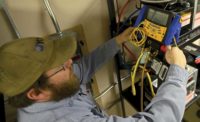According to the Air-Conditioning and Refrigeration Institute (ARI), April’s combined air conditioning and air-source heat pump shipments were up 7 percent over last year, totaling 559,774. The year-to-date shipment totals, down 24 percent from 2006, are approximately 2 million units. April heat pump shipments are down just 0.2 percent, totaling 164,585 units shipped. Year-to-date numbers, however, report the 613,708 heat pump shipments down 17 percent.
On the heating side, vent-free heaters are up 6.1 percent. Gas furnace shipments dropped 11.7 percent in April, 20.7 percent year-to-date; and oil furnace shipments have dropped 15.8 percent in April, 3.6 percent year to date.
Distributors, who felt the 13 SEER crunch last year, are seeing some relief this year. According to the Heating, Airconditioning, and Refrigeration Distributors International (HARDI), April’s sales dollars increased 5 percent, lending to the overall yearly increase of 0.7 percent. Fifty-three of the 95 distributorships reporting showed that their year-to-date sales had increased, and 56 showed increased inventories.
HARDI’s Management Methods Committee, which oversees monthly sales trends, also reported that unitary equipment sales were off by 20 percent in the first quarter. James Healy, HARDI’s director of education, pointed out that equipment represents half the sales dollars for the typical HARDI distributor. “This would suggest that the repair parts and supplies business has been good.”
In spite of the market’s unsteadiness, many contractors are meeting the challenges that this declining market presents. Louis Hobaica, service and general manager, Hobaica Services, Phoenix, is currently at 15 percent growth as compared to last year’s 12 percent growth rate overall.
“Material, equipment, and fuel costs continue to rise, as does our pricing,” he explained. “The market is continuing to bear the increased pricing.”
Hobaica understands that in order for the market to continue to bear the price increases, quality and education are imperative.
“We continually focus on quality, efficient, and professional installations while maintaining complete customer satisfaction,” he noted. “The key is in customer education.”
Another consequence of the slowing economy that is affecting contractors is the rising lack of customer credit.
“We are seeing an increase in credit turn downs,” said Richard Dykstra Sr., general manager, D.M. Dykstra & Co., Nicor Home Services, Crestwood, Ill. “Homeowners seem to be looking at repairing a lot more than replacing, I think in an effort to try and save a little money to fill their gas tanks.”
The higher gas prices aren’t just affecting Dykstra’s customers; they are affecting his company as well. “It’s costing us much more to keep the trucks on the road,” he said. “We are trying to focus on tighter call routing, and we are taking full advantage of our supply houses’ delivery services to our shop and to our jobsites.”
On the commercial side of the industry, the story is a little different. Although commercial contractors are still affected by increasing gas and materials prices, many are witnessing a renewed interest in old equipment replacements and a strong increase in the commercial new construction market.
“There are a lot of buildings that were put up at the tail end of the building boom in the early to mid-80s,” said Eric Binder, president, Climate Engineering Inc., Denver. “All that 20-year-old plus equipment is now in bad need of repair and/or replacement.”
In the Denver market, a large amount of commercial building vacancies that occurred in 2000 has effectively shifted commercial realty to a buyers’ market.
“This suddenly made HVAC needs more visible as tenants began renegotiating leases,” he noted. Binder’s company has since seen an increase in the company’s service and replacement business that has been fueled by the competition of commercial building owners working to retain tenants.
“I feel the market is pretty good right now, as long as we focus on the right buildings and building owners,” Binder said. “This has allowed us to maintain our margins and increase our volume.”
Publication date:06/25/2007
Copyright ©2025. All Rights Reserved BNP Media.
Design, CMS, Hosting & Web Development :: ePublishing





